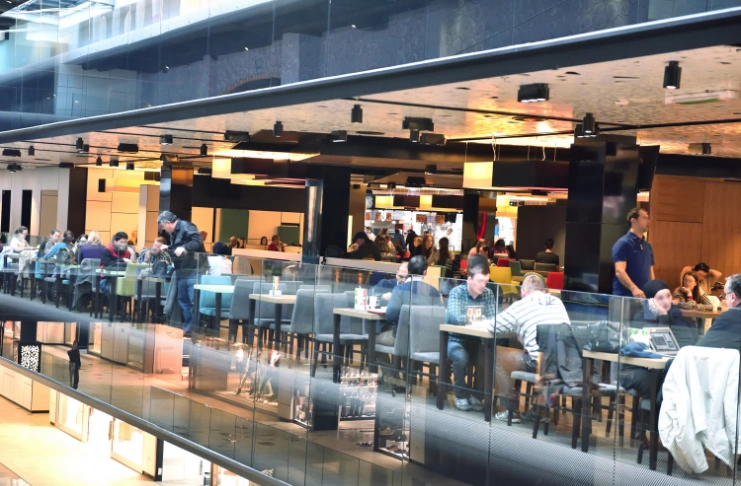The restaurant industry today runs on thin margins and volatile variables. Labor, logistics, inventory, pricing—each one is a potential fault line. And today, those fault lines are more exposed than ever. Supply chains remain fragile. Labor costs are rising. Digital transformation is uneven. Customer expectations are immediate, public, and unforgiving.
In fact, most restaurant operators today don’t fail because of bad food. They fail because they can’t operationalize consistency, control costs, or scale service without breaking something else.
This article outlines the most pressing restaurant problems and solutions that owners, operators, and managers must consider to build resilient, profitable businesses.
INDUSTRY INSIGHT
| The restaurant industry is notoriously challenging, with many establishments failing within the first few years. According to data from the U.S. Bureau of Labor Statistics, approximately 20.4% of businesses fail in their first year, and about 49.4% fail within five years. While these figures encompass all industries, the restaurant sector is particularly vulnerable due to several unique challenges, such as poor financial planning, high staff turnover, and inadequate market research. |
Most Common Restaurant Problems and Solutions
Below are the key challenges restaurants face today, along with practical solutions to overcome them.
Problem 1: Insufficient Capital and Poor Financial Planning

Many restaurant owners underestimate the capital required to sustain operations until the business becomes profitable. Unexpected expenses, high overhead costs, and poor budgeting can quickly deplete resources. That’s why it’s crucial to have sufficient funds not only for the initial setup but also to cover operating expenses for at least six months. How?
Have a Capital Reserve
Develop a comprehensive business plan with realistic financial projections that account for at least 15-20% cost overruns. Establish a capital reserve sufficient to cover 6-12 months of operating expenses, not just the standard 3-6 months many new owners plan for.
Consider structured financing options that combine equity, debt, and potentially revenue-based financing to create flexibility during seasonal fluctuations.
Cash Flow Optimization
Implement rolling 13-week cash flow forecasting to anticipate shortfalls before they become critical. Negotiate favorable payment terms with suppliers (net 30 or net 45 when possible) while offering small discounts (1-2%) for customers paying with cash rather than cards to reduce processing fees.
Stagger major purchases and equipment replacements to avoid simultaneous capital expenditures that could strain liquidity.
Cost Control Systems
Deploy digital inventory management systems that track food costs in real time and automatically flag variances above predetermined thresholds. Implement “theoretical vs. actual” inventory analysis to identify waste, theft, or portioning inconsistencies.
Conduct bi-weekly prime cost analysis (combined food and labor costs) with a target of keeping these expenses between 55-65% of total revenue, depending on your restaurant concept.
Problem 2: Inadequate Market Research and Poor Location

Choosing the right location for your restaurant is important. A spot with low foot traffic, limited parking, or poor visibility can hinder its success.
Plus, failing to conduct thorough market research to understand customer preferences and local competition can lead to misaligned offerings.
So, how can you choose the right location?
Data-Driven Site Selection
Before signing any lease, conduct pedestrian traffic studies at different times of day and on different days of the week. Calculate the “capture rate” you would need from passing traffic to meet revenue targets.
Analyze cellular data heatmaps (available from specialized marketing firms) to understand movement patterns in prospective areas. Also, consider calculating the visibility index of potential locations, i.e., how visible the storefront is from multiple approaches.
Competitive Differentiation Strategy
Conduct a detailed analysis of all competitors within a 3-5 mile radius, documenting their menu offerings, price points, service styles, and customer demographics. Identify specific underserved niches or dayparts where your concept could fill a gap.
Develop a unique value proposition that addresses specific customer pain points not currently being resolved by existing restaurants.
Market Testing Before Full Launch
Before full-scale opening, test your concept through pop-up events, food trucks, or ghost kitchen operations to gather customer feedback on menu items, pricing, and overall concept viability.
Run focus groups with representative local demographics to refine offerings. This approach allows for menu and concept refinement before committing to the high fixed costs of a full restaurant launch.
Problem 3: Lack of Experience and Ineffective Management

Running a restaurant requires more than culinary skills. Owners without industry experience may struggle with staff management, inventory control, and customer service. Ineffective management can further lead to operational inefficiencies and a decline in service quality. What can you do to mitigate it?
Structured Management Development
Create a tiered management training program that covers all operational aspects: inventory management, staff scheduling, conflict resolution, food safety compliance, and financial literacy.
Implement a management by walking around (MBWA) protocol that requires managers to engage with each staff member and observe all restaurant zones during every shift.
Standard Operating Procedures (SOPs)
Develop comprehensive, visual SOPs for every restaurant function, from opening procedures to cleaning protocols. Create digital versions that are accessible via tablets or smartphones and positioned at workstations.
Include troubleshooting guides for common problems to empower staff to resolve issues independently. Review and update these SOPs quarterly to incorporate improvements and address emerging challenges.
Technology Integration for Efficiency
Implement an integrated restaurant management system that connects POS, inventory, staff scheduling, and financial reporting. Use kitchen display systems rather than printed tickets to improve accuracy and timing between the front and back of the house.
Deploy self-ordering kiosks or tableside tablets to reduce order-taking labor while increasing check averages through consistent upselling prompts.
Problem 4: Inconsistent Food Quality and Service

Consistency is key in the restaurant business, particularly in delivering excellent customer service. Variations in food quality, portion sizes, or service can erode customer trust and lead to negative reviews, significantly impacting a restaurant’s reputation and customer base. Solution?
Recipe Management Systems
Implement digital recipe management with visual preparation guides, precise measurements, and plating specifications. Encourage chefs to use digital scales rather than volume measurements for ingredients.
Photograph standard plating for every menu item and display these images in the preparation areas. Conduct weekly blind taste tests, in which management audits randomly selected menu items against documented standards.
Quality Control Protocols
Establish a formal food quality audit system with daily pre-service tastings of key items. Create a ‘control points’ checklist for each dish that identifies the 3-5 elements most crucial to its success.
Implement a ticket time monitoring system that alerts management if preparation time exceeds established standards. This will allow for immediate intervention before service quality suffers.
Service Standardization and Training
Develop a comprehensive service sequence with specific timing targets for each step of the guest experience. Create role-playing scenarios that train staff on handling common service challenges.
Implement a ‘service recovery’ protocol that empowers all staff to resolve guest issues on the spot without manager approval up to a predetermined value (typically $20-50, depending on the restaurant’s price point).
Problem 5: Failure to Adapt to Market Trends

The restaurant industry is dynamic, with evolving customer preferences and technological advancements. Restaurants that fail to adapt to trends such as online ordering, delivery services, or dietary preferences risk becoming obsolete. So, what should you do?
Continuous Concept Evolution
Schedule quarterly menu engineering meetings to analyze sales data and customer feedback, retire underperforming items (bottom 10-15% of sellers), and test replacements.
Conduct competitive analysis biannually to identify emerging trends in your market. Create a ‘concept evolution roadmap’ that plans incremental changes over 24 months rather than sporadic major overhauls.
Diversification of Revenue Streams
Develop multiple revenue channels beyond traditional dine-in service: catering programs, meal kits, specialty food products, cooking classes, or subscription services. Each additional revenue stream should target a minimum of 15-20% contribution margin.
Create a dedicated position or team responsible for managing these alternative revenue channels to ensure they receive appropriate focus.
Technology Adoption Strategy
Create a technology roadmap that identifies and prioritizes innovations based on ROI potential. Start with customer-facing technologies that directly impact revenue (online ordering, reservation systems) before implementing back-of-house efficiency tools.
Allocate 2-3% of annual revenue to technology investments, with clear KPIs established to measure their impact.
Problem 6: Poor Marketing and Online Presence

In today’s digital age, a strong online presence is essential. Restaurants that neglect marketing efforts or fail to engage with customers on social media platforms may struggle to attract and retain repeat business.
Comprehensive Digital Strategy
Develop an integrated digital marketing plan that encompasses website optimization, search engine marketing, email campaigns, and social media presence. Allocate a marketing budget based on customer acquisition costs and lifetime value calculations for each channel.
Create a content calendar that ensures consistent messaging across all platforms while maintaining freshness and relevance.
Customer Data Utilization
Implement a robust CRM system that tracks guest preferences, visit frequency, and spending patterns. Use this data to create personalized marketing campaigns aiming for higher conversion rates.
Develop a tiered loyalty program that rewards frequent customers while providing valuable data on behavior patterns. Train staff to subtly collect and record guest preferences during service.
Reputation Management Systems
Deploy automated systems that monitor reviews across all platforms and alert management to negative feedback requiring immediate response. Develop templated but customizable responses for common issues.
Create a review generation process that subtly encourages satisfied customers to share their experiences online while identifying and addressing concerns from dissatisfied customers before they leave negative reviews.
Problem 7: High Staff Turnover

The restaurant industry often experiences high employee turnover, which can disrupt operations and affect service quality. Investing in staff training and creating a positive work environment can help retain skilled employees.
Career Progression Framework
Create clearly defined career paths for all positions, from dishwasher to management, with specific skill requirements for advancement. Implement a “skills passport” system where employees can document mastery of various skills and responsibilities.
Establish mentor relationships between experienced staff and newcomers, with incentives for successful knowledge transfer.
Competitive Compensation Structures
Design compensation packages that include both competitive base pay and performance-based incentives tied to specific, measurable outcomes. Consider profit-sharing programs that give staff a stake in the restaurant’s success.
Implement scheduling software that optimizes shifts based on business needs and employee preferences, thus improving work-life balance.
Positive Workplace Culture
Conduct regular “temperature checks” through anonymous staff surveys to identify issues before they lead to turnover. Create recognition programs celebrating staff achievements beyond sales targets, including customer service excellence, operational innovations, and team support.
Schedule regular team-building activities and staff meals that foster camaraderie and open communication channels between management and staff.
Problem 8: Overexpansion

Expanding too quickly without ensuring the stability of the initial location can strain resources and dilute brand quality. It’s important to establish a solid foundation before considering growth. How?
Scalable Systems Development
Before expanding to additional locations, document and systemize all operational procedures to ensure they can be replicated without the owner’s constant presence.
Create a “concept booklet” that codifies every aspect of the restaurant’s operation, from design elements to vendor relationships.
Develop a proprietary training system that can quickly bring new staff up to standards regardless of location.
Data-Driven Expansion Decisions
Establish specific performance benchmarks that must be achieved before expansion is considered: sustained profitability over 12-18 months, management bench strength, systems documentation, and capital reserves.
Develop a site selection matrix with weighted criteria specific to your concept that objectively evaluates potential new locations. Before committing to traditional expansion, consider controlled growth through less capital-intensive models (licensing, ghost kitchens).
Multi-Unit Management Infrastructure
Create a multi-tiered management structure with clear role differentiation between location-specific and system-wide responsibilities. Implement centralized purchasing systems that leverage increased buying power while maintaining quality standards.
Develop standardized reporting that provides location-specific insights while enabling cross-location performance comparisons.
Problem 9: Ignoring Customer Feedback

Customer feedback provides valuable insights into areas needing improvement. Restaurants that ignore or dismiss feedback risk alienating their customer base and missing opportunities for growth. What’s the solution?
Systematic Feedback Collection
Implement multiple feedback channels beyond standard comment cards: QR-code-based digital surveys, tableside manager check-ins, and follow-up emails.
Design feedback instruments that gather actionable data rather than generalized impressions, with questions focused on specific aspects of the experience that management can directly address.
Closed-Loop Feedback Process
Create a formal process for reviewing, categorizing, and acting on customer feedback, with clear ownership and timelines for addressing issues. Implement a “you said, we did” communication strategy that informs customers about improvements made based on their suggestions.
Develop a feedback prioritization matrix that weighs customer comments based on frequency, impact on satisfaction, and feasibility of implementation.
Continuous Improvement Culture
Schedule monthly meetings where staff from all levels can suggest improvements based on customer feedback and operational observations. Create a small budget for testing customer-suggested improvements without requiring extensive approval processes.
Recognize and reward staff members who successfully implement changes that measurably improve customer satisfaction or operational efficiency.
Problem 10: Rising Operational Costs

Increases in rent, utilities, and ingredient prices can squeeze profit margins. These rising expenses can lead to financial instability without effective cost-control measures. The best solution:
Strategic Purchasing Practices
Implement a formal RFP process for major suppliers with annual or bi-annual reviews. Develop relationships with multiple suppliers for key ingredients to create negotiating leverage and supply chain resilience.
Consider joining purchasing cooperatives to access volume discounts typically only available to larger operations. Create a systematic approach to evaluating price increases, requiring justification and potential renegotiation.
Menu Engineering for Profitability
Conduct a detailed contribution margin analysis of all menu items rather than focusing solely on food cost percentage. Implement a flexible pricing strategy that adjusts certain items seasonally based on input cost fluctuations.
Develop recipes for delicious food that maintain flavor profiles while allowing for ingredient substitutions based on market conditions and price fluctuations.
Energy and Resource Efficiency
Conduct an energy audit to identify opportunities to reduce utility costs through equipment upgrades or operational changes. Implement water-saving fixtures and energy-efficient lighting, with typical payback periods of 6-18 months.
Create staff incentive programs tied to resource conservation metrics, sharing a percentage of the savings with the team to encourage engagement.
Conclusion
By implementing the solutions mentioned in the article, restaurant owners and operators can systematically address the common challenges that lead to failure in the industry. The key is to approach each problem with structured, data-driven strategies rather than reactive, ad hoc solutions.
Frequently Asked Questions
1. What is the biggest problem in the restaurant industry?
The biggest problem is maintaining profitability amid rising costs. Labor, rent, and raw materials are increasingly expensive, yet customers push back against higher menu prices. This makes it harder for restaurants to protect their margins, even when sales volume appears healthy on paper.
2. What is the most common complaint at restaurants?
The most frequent complaint is slow or inconsistent service. Diners expect speed, accuracy, and attentiveness. Long waits, missed items, or indifferent staff are more likely to trigger bad reviews than mediocre food. Service is where first impressions—and reputations—are made or broken.
3. How do you know if a restaurant is struggling?
A struggling restaurant often shows it in plain sight: declining foot traffic, frequent staff turnover, erratic service, unpolished menus, and a lack of online activity. You’ll also notice reactive discounting, poor ambiance upkeep, and a management team stuck in firefighting mode.
4. How can I make my restaurant run better?
Start by optimizing the fundamentals: tighten inventory management, reduce menu sprawl, invest in staff training, and adopt restaurant management software to streamline operations. Success in this business isn’t about doing more. It’s about doing fewer things better and more consistently.
5. What is the biggest threat to the restaurant?
The single biggest threat is operational disruption. Whether it’s a supplier delay, a viral bad review, or the sudden loss of key staff, most restaurants don’t have systems in place to absorb shocks. In a high-churn, low-margin business, resilience is everything.
6. Why are restaurants struggling right now?
Restaurants are struggling due to a combination of labor shortages, higher input costs, and shifting consumer behavior. Many operators haven’t fully adapted to the digital-first, delivery-heavy, experience-driven dining environment. Those still relying on pre-pandemic models are falling behind quickly.
7. What are the challenges facing the foodservice industry?
The foodservice industry faces labor instability, inflation-driven costs, fragmented supply chains, and fast-changing customer expectations. On top of that, tech integration and digital marketing are no longer optional. Restaurants must juggle all these while still delivering consistent, high-quality dining experiences.
8. What’s the biggest food challenge?
Maintaining consistent food quality at scale is the toughest challenge. During peak hours or when ingredients are running low, delivering the same dish with the same flavor and presentation becomes a test of systems, training, and team coordination.
9. What are the challenges of operating a restaurant?
Running a restaurant demands constant attention to staffing, food costs, licensing, cleanliness, compliance, and guest satisfaction. It’s an industry where everything is urgent, and nothing can be neglected. Without strong systems, even the best food won’t keep a business afloat.
10. What is an example of a food challenge?
One example may be dealing with a sudden recall or spoilage of a core ingredient. If your signature dish relies on a product that becomes unavailable or unsafe, you must quickly rework the recipe, manage expectations, and keep service running without damaging your brand.
11. How can restaurant operations be improved?
Focus on standardizing daily processes, integrating a smart POS system, and using data to refine your menu and labor schedules. Ongoing staff training, tighter supplier coordination, and customer feedback loops will also improve operational efficiency and reduce unnecessary losses.





